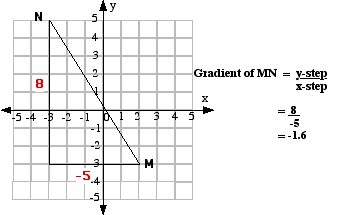A Reminder
|
|
= |
|
Gradients can be given as integers, fractions or decimals.
Types of gradient
|
A line sloping upwards from left to right has a positive gradient. |
m is positive |
|
|
A line sloping downwards from left to right has a negative gradient. |
m is negative |
|
|
Parallel lines have the same gradient. |
m1 = m2 |
|
|
A horizontal line has a gradient of 0. |
m = 0 |
|
|
The gradient of a vertical line is undefined. |
m is undefined |
Click Here for practice at calculating gradients.
|
Example
|
Answer
|
|
What is the gradient of the line below?
|
 |
| What is the gradient of the line joining the points P (1, 2) to Q (4, 5)? |
Draw a diagram
|
| What is the gradient of the line joining the points M (2, -3) to N (-3, 5)? |
Draw a diagram
|





